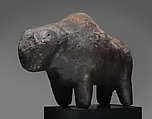Returned to lender The Met accepts temporary loans of art both for short-term exhibitions and for long-term display in its galleries.
Boli
Not on view
Segu’s leaders maintained political power through the possession and control of four potent occult objects known as “the great boliw of Segu.” Sometimes described as portable altars, boliw are understood to be a microcosm of the universe. Their surfaces are formed by packing, layering, and blending sacrificial materials into an indeterminate form that is believed to be a source of mystical power deliberately inaccessible to the uninitiated. Boliw were the primary targets of the jihad waged by the Umarian army. At the time of ‘Umar Tal’s victory over Segu, the leader’s chronicler Mamadou Ali Cam wrote:
The Differentiator [‘Umar Tal] then said to them [Bina Ali and the defeated Bamana]: “Now break them [the idols], crush them, and build mosques in all of Segu.” Ali said: “You mock me. You alone can smash them and survive. Anyone else would not live to tell the tale.” . . . Then the Unique One [‘Umar Tal] rose up and crushed [the idols] with his powerful hand, imitating the action of the Elected One [Muhammad] at Medina.”
Due to rights restrictions, this image cannot be enlarged, viewed at full screen, or downloaded.
This artwork is meant to be viewed from right to left. Scroll left to view more.




